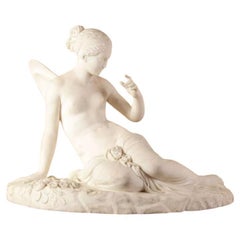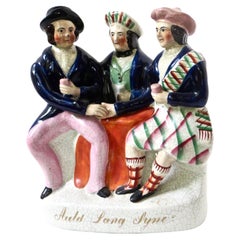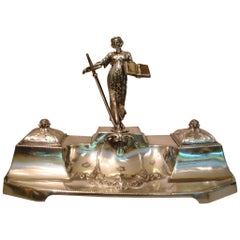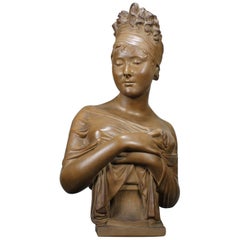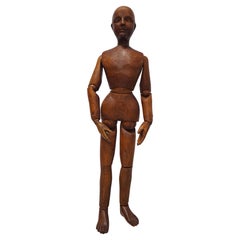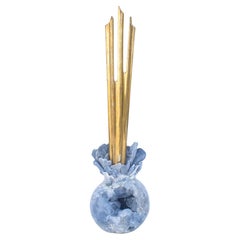European Figurative Sculptures
to
1,295
9,295
1,424
253
824
3,073
5,398
1,677
1,743
1,945
965
257
122
464
453
180
278
332
314
197
114
1,325
1,027
820
466
461
324
232
227
167
128
70
55
54
53
38
36
23
16
4,796
3,196
2,888
2,458
1,750
6,534
3,677
10,972
3,521
3,136
1,921
1,580
Height
to
Width
to
10,972
10,009
10,425
154
144
141
86
73
Place of Origin: European
Statuary White Marble Figure of Psyche, circa 1850
Located in Tyrone, Northern Ireland
A finely carved white statuary marble figure of Psyche.
In Greek mythology, Psyche is the goddess of the soul and wife of Eros, god of love. She was the most beautiful girl in the w...
Category
19th Century Neoclassical Revival Antique European Figurative Sculptures
Materials
Statuary Marble
Staffordshire "Auld Lang Syne" '3' Figured Porcelain circa 1850. English
By Staffordshire
Located in Incline Village, NV
Three figures are seated at a table where rests a jug of ale; all on a rectangular oval base where the title of the porcelain is stated in gold gilt script "Auld Lang Syne...
Category
Mid-19th Century Victorian Antique European Figurative Sculptures
Materials
Porcelain
Art Nouveau sculpture desk Inkwell Stand, Figure of the Law and Justice 1900´s
By WMF Württembergische Metallwarenfabrik
Located in Buenos Aires, Olivos
WMF, superb Art Nouveau desk inkwell. Wonderful work. Maker mark for WMF. Model 288. The Lady is the Law. Similar to the justice sculpture See Photos...
Category
Early 20th Century Art Nouveau European Figurative Sculptures
Materials
Spelter
$1,440 Sale Price
42% Off
French 19th Century Terracotta Bust of Madame Récamier, After Jean-Antoine Houdo
By Jean-Antoine Houdon
Located in Los Angeles, CA
A fine French 19th century terracotta bust of "Madame Récamier (French, 1777-1849)" The coyly gazing downward beauty, holding a veil across her chest r...
Category
19th Century Neoclassical Antique European Figurative Sculptures
Materials
Terracotta
19th Century French Articulated Mannequin
Located in San Francisco, CA
Mid-late 19th century expertly hand carved and fully articulated artist mannequin
Category
Late 19th Century Primitive Antique European Figurative Sculptures
Materials
Walnut
18th Century Italian Sunray on a Blue Celestite Sphere with Blue Coral
By Interi
Located in Dublin, Dalkey
18th century Italian gold leaf sunray mounted on a blue celestite sphere and wrapped in perfectly coordinating blue preserved coral.
The 18th century gold leaf sunray was once a par...
Category
18th Century Rococo Antique European Figurative Sculptures
Materials
Coral, Quartz, Rock Crystal, Gold Leaf
A Pair French 19th Century Bronze Nude Maidens Torchere, Carrier-Belleuse Attr.
By Albert-Ernest Carrier-Belleuse
Located in Los Angeles, CA
Very fine and monumental pair of French 19th century patinated bronze figural torchere sculptures titled "La Nuit" (The Night) attributed to Albert Carrier-Belleuse (French, 1824-188...
Category
Late 19th Century Beaux Arts Antique European Figurative Sculptures
Materials
Marble, Bronze
19th Century Giltwood Polychrome Statue of Madonna
Located in Dallas, TX
19th century giltwood polychrome statue of Madonna is a superbly artistic rendition of the Mother of Jesus, uncharacteristically holding our both han...
Category
1850s Antique European Figurative Sculptures
Materials
Giltwood
19th Century Highly Carved French Oak Sculpture of a Man Harvesting Wine Grapes
Located in Dallas, TX
This beautiful sculpture has been carved from solid French oak during the latter half of the 19th century. The style is that of Black Forest, with realistic depictions of branches, leaves, grapes, and more. Originally a French clock, most of the timing mechanisms have long been removed. The elaborate carving depicts a man harvesting wine grapes on rocky terrain dotted with vegetation. Our gatherer, who is clad in an overcoat and large brimmed hat, is carrying a hod (hotte in French) full of freshly picked grapes. A large wooden bucket...
Category
19th Century Black Forest Antique European Figurative Sculptures
Materials
Wood
Bronze Figure of "Danseuse a La Lyre" by Mathurin Moreau
By Mathurin Moreau
Located in Norwood, NJ
Mathurin Moreau (French, 1822-1912), Danseuse a la Lyre, a bronze figure of a woman with her arms raised holding a lyre, signed "Math. Moreau/Hors Concours" and stamped "MEDAILLE D'H...
Category
Late 19th Century Belle Époque Antique European Figurative Sculptures
Materials
Bronze
Bronze Plaque of Napoleon Crossing the Alps after the Painting by David
Located in London, GB
Bronze plaque in high relief of Napoleon crossing the Alps after the famous painting by Jacques-Louis David (30 August 1748-29 December 1825...
Category
Early 1800s Grand Tour Antique European Figurative Sculptures
Materials
Bronze
Bronze Sculpture "Athlete" by Max le Verrier
By Max Le Verrier
Located in Montreal, QC
Bronze Sculpture "Athlete" by Max le Verrier resting on stone base Stamped: "M Le Verrier" on underside. France: circa 1937 Similar model is illustrated i...
Category
1930s Art Deco Vintage European Figurative Sculptures
Materials
Bronze
Guframini God
By Gufram Furniture
Located in Milan, IT
Gufram icons have become smaller and have turned into Guframinis! Designed in a 1:8 scale the new miniatures perfectly reproduce the famous original sculptures. Each "mini" creation ...
Category
2010s European Figurative Sculptures
Materials
Resin
$483 / item
Emile Laporte "King of the Gauls and Son" Bronze
Located in Astoria, NY
Emile Henri Laporte (French, 1858-1907) "King of the Gauls and his Son" also known as "Vercigentorix with His Son" Patinated Bronze Sculpture, late 19th century, depicting the King o...
Category
Late 19th Century Antique European Figurative Sculptures
Materials
Bronze
1750 Venezia Italy Polychrome Lacquered and Wooden Engraved Sculpture
Located in Brescia, IT
This is a rare wooden sculpted man figure carved and lacquered in polychrome. This elegant piece hails from the Mid-18th Century, Venezia.
The curved shape, on the front and on the s...
Category
Mid-18th Century Rococo Antique European Figurative Sculptures
Materials
Wood, Lacquer
A French 19th-20th Century Carved White Marble Fountain Sculpture with Children
Located in Los Angeles, CA
A fine and charming French 19th-20th century carved white marble whimsical group sculpture depicting two putti (Children) playing with a dolphin, fitted for use as a fountain, Paris,...
Category
Early 1900s Louis XV Antique European Figurative Sculptures
Materials
Marble
$9,985 Sale Price
20% Off
Hercules Burnish brass cup with Carrara marble base
Located in Firenze, FI
Elevate your kitchen decor with our burnished brass cup, perfect for adding a touch of rustic charm to your space. Made of high-quality brass and featuring a...
Category
2010s European Figurative Sculptures
Materials
Marble, Brass
$1,610 / item
Dancing Faun Candle holder in bronze by Patrick Laroche
By Laroche
Located in Paris, FR
Dancing Faun with candle holder.
Materials: Patinated bronze Brown, signed and justified EA on the base.
Made in France by Patrick Laroche, Meilleur Ouvrier de France award in the Sc...
Category
21st Century and Contemporary Modern European Figurative Sculptures
Materials
Bronze
Bronze Group by Emile-Andre Boisseau La Crépuscule (Dusk)
Located in Norwood, NJ
Emile-Andre Boisseau (1842-1923)
French patinated bronze figural group: Le Crepuscule. Mounted on marble base. Signed 'Boisseau.' and with foundry cachet 'THIEBAUT FRERES'
Emile Andr...
Category
Late 19th Century Antique European Figurative Sculptures
Materials
Griotte Marble, Bronze
20th Century French Pair Of Plaster Sculptures Of Mermaids
Located in High Point, NC
Discover the enchanting allure of this exquisite pair of 20th Century French plaster sculptures, depicting two graceful mermaids. Each piece captures the ethereal beauty and elegance...
Category
20th Century European Figurative Sculptures
Materials
Plaster
Patinated bronze sculpture "Le Torrent" by Jean-Baptiste Germain
By Jean-Baptiste Germain
Located in Autonomous City Buenos Aires, CABA
Patinated Bronze Sculpture "Le Torrent" by Jean-Baptiste Germain
Patinated bronze sculpture titled "Le Torrent" by French sculptor Jean-Baptiste Germain (1841-1910). The piece depict...
Category
20th Century Art Nouveau European Figurative Sculptures
Materials
Bronze
19th Century White Marble French Fisherman Sculpture, after Carpeaux
Located in Vicoforte, Piedmont
Large white marble statue from the second half of the 19th century. Sculpture of remarkable quality depicting a young Neapolitan fisherman who laughs mischievously while holding a sh...
Category
1870s Antique European Figurative Sculptures
Materials
Marble
French Art Deco Walnut Sculpture of a Nude Woman, circa 1920
Located in Rochester, NY
Exceptional and expressively carved solid walnut near life Size statue of nude woman raised on attached fluted column pedestal base in overall beautifully aged original rich surface ...
Category
Early 20th Century Art Deco European Figurative Sculptures
Materials
Walnut
Portuguese Palissy Majolica Tortoise Figure
Located in Chelmsford, Essex
Portuguese Portuguese Palissy Majolica figure which features a tortoise. Colouration: brown, ochre, grey, are predominant.
Category
1890s Victorian Antique European Figurative Sculptures
Materials
Majolica
High relief -Hippodamia's rape of the centaur Eurythion -white Carrara marble
By Laboratorio Todini
Located in Tarquinia, IT
Abduction of Hippodamia by the centaur Eurizione
Made n Italy
High relief carved on white Carrara marble representing the "Rape of Hippodamia"
The total weight is about 23 kg
italian...
Category
Early 2000s Classical Greek European Figurative Sculptures
Materials
Marble
A Pair of Linden Wood Austrian Angels
Located in Chicago, IL
Exquisitely carved in linden wood, this pair of Austrian Baroque angels epitomizes the dynamic movement and dramatic expression characteristic of the period. Each figure is rendered ...
Category
Early 19th Century Antique European Figurative Sculptures
Materials
Wood
$45,000 / set
Monumental "Cabina Dell'elba" One-Off Piece by Aldo Rossi, Italy, 1980s
By Aldo Rossi
Located in Milan, IT
Cabina dell'Elba construction by Aldo Rossi.
This piece was manufactured in 1984 for Pitti Fashion Week show.
It's equipped as changing room with wall mirror, stool, wall hang and ...
Category
1980s Vintage European Figurative Sculptures
Materials
Brass
Sculpture of Venus in Resin and Metal Base, Small Model.
Located in Saint-Ouen, FR
Sculpture of Venus in resin and metal base, small model.
Venus is the goddess of love, seduction and beauty in Roman mythology. She is the equivalent of the Greek goddess Aphrodite....
Category
21st Century and Contemporary Modern European Figurative Sculptures
Materials
Metal
Gunnel Sahlin for Kosta Boda Fruits Art glass , 1990s
By Gunnel Sahlin
Located in Delft, NL
Gunnel Sahlin for Kosta Boda Fruits Art glass , 1990s
Category
1990s Mid-Century Modern European Figurative Sculptures
Materials
Art Glass
Jacob Jensen Danish Viking Figure, 1960s
By Jacob Jensen
Located in San Juan Capistrano, CA
Jacob Jensen Danish Viking Figure, 1960s.
Category
20th Century Mid-Century Modern European Figurative Sculptures
Materials
Beech, Teak
$200 Sale Price
20% Off
18th century polychromed pinewood santos figure/procession mannequin/capipote
Located in Brecht, BE
an extraordinary piece, a very rare find this capipote/santos figure,
lovely carving, wonderful soft expression on the polychromed face, bought from an Italian collector, who had it...
Category
Mid-18th Century Antique European Figurative Sculptures
Materials
Pine
Henri PEINTE (1845-1912) : "Sarpedon", patinated bronze sculpture C.1890
By Henri Peinte
Located in SAINT-OUEN-SUR-SEINE, FR
Henri PEINTE (1845-1912, France) : "Sarpedon"
Dark brown-black patinated bronze sculpture representing Sarpedon, son of Greek god Zeus and Europe
Bears the signature "H.Peinte" an...
Category
1890s Greek Revival Antique European Figurative Sculptures
Materials
Bronze
An antique 18th century Walnut European Santos - Saint figure on a plinth
Located in Leesburg, VA
An antique 18th century Walnut Figural Statue of Saint Peter on a plinth
Anonymous
Northern Europe, probably Belgium; first-half of the 18th century
Walnut
Approximate size: 17 (h) x 4.25 (w) x 4.25 (d) in.
The present sculpture, perfectly suited for a curiosity cabinet or English-European country styled home, was likely realized for a church side chapel or choir stall niche. The serious look of the saint’s face...
Category
Early 18th Century Baroque Antique European Figurative Sculptures
Materials
Walnut
Paul Wunderlich Minotaur Bronze Sculpture
By Paul Wunderlich
Located in New York, NY
Bronze and brass sculpture by German artist Paul Wunderlich (1927-2010) of a Minotaur, complete with interchangeable large and small phallus. Great table or console sculpture as it stands over 30 inches tall. I first saw this incredible sculpture at an antique shop...
Category
1980s Vintage European Figurative Sculptures
Materials
Brass, Bronze
Art Nouveau Bronze Sculpture of Eastern Dancer by Franz Rosse(German, 1858-1900
Located in Shippensburg, PA
FRANZ ROSSE
German, 1858-1900
"Orientalische Tänzerin mit Schalmei” (1888)
Patinated bronze over rouge marble Signed verso "F. Rosse fec. 88"
Item # 10...
Category
20th Century Art Nouveau European Figurative Sculptures
Materials
Bronze
Late 19th Century French Classical Plaster Foot
Located in London, GB
A statement patinated plaster academic study of an oversized foot, cast from a classical sculpture. French, c. 1890.
Category
Late 19th Century Antique European Figurative Sculptures
Materials
Plaster
23” Raoul Larche 'L'Idée, Allégorie sur un Rocher' Gilt Bronze Inkwell
By François-Raoul Larche
Located in Dallas, TX
Raoul Larche (1860-1912) Monumental Inwell vide pouch.
'L'Idée, Allégorie sur un Rocher' A Gilt-Bronze Inkwell, circa 1900
Figural Centerpiece, Inkwell and vide pouch.
Gilt-bronze
H...
Category
1910s Art Nouveau Vintage European Figurative Sculptures
Materials
Bronze
Italian Seated Figure of a Carrara Marble Sculpture of a Vestal Virgin
Located in Houston, TX
The perfection in the carving technique makes this sculpture very
Special. It is carved from a fine carrara white marble with artistic
Perfection. The folds in her gown and drapin...
Category
Late 19th Century Antique European Figurative Sculptures
Materials
Carrara Marble
$27,200 Sale Price
20% Off
Hyllested Danish Mid-Century Art Pottery Eskimo Figure
Located in Bishop's Stortford, Hertfordshire
A charming and uncommon Danish mid-century art pottery eskimo figure made by Hyllested Keramik and dating from around 1960. This highly collectable figure is referenced by some as re...
Category
1960s Mid-Century Modern Vintage European Figurative Sculptures
Materials
Stoneware
Ant Nelson, Bust Of A Woman, Alabaster, Late 19th Century
By Anton Nelson
Located in MARSEILLE, FR
Beautiful alabaster bust of an elegant woman with a hat and a ribbon in her hair; the base is decorated with flowers/leaves
This bust is signed on the back Ant Nelson: this is the p...
Category
Late 19th Century Art Nouveau Antique European Figurative Sculptures
Materials
Alabaster
2006 Bronze Sculpture by Ugo Riva Innocente Provocazione
Located in Brescia, IT
This is an intense bronze sculpture created by the Italian artist Ugo Riva, in 2006. Lost wax bronze on iron basement.
The title of this artwork is "I...
Category
Late 20th Century Post-Modern European Figurative Sculptures
Materials
Bronze
Plaster Sculpture of Eros After the Antique
Located in Wormelow, Herefordshire
A plaster Italian sculpture of Eros of Centocelle after the antique set on tapering mahogany pedestal finished in a French polish.
Eros, the God of love, is depicted looking down to his right in an impressive scale with a beautiful time worn look.
The base of the plaster is impressed with '1378 TORSE ANTIQUE AMOUR...
Category
Late 19th Century Neoclassical Antique European Figurative Sculptures
Materials
Plaster, Wood, Mahogany
An Exhibition Lifesize Statuary Marble Figural Group
Located in Brighton, West Sussex
An Important Lifesize Statuary Marble Figural Group of a Mother and Her Two Children, Entitled 'Mamma ce n'è una sola' (You only have one mother), By Silverio Martinoli (Italain, 183...
Category
19th Century Victorian Antique European Figurative Sculptures
Materials
Carrara Marble
Max Le Verrier lighted Sculpture Aube French Art Deco vintage Table Lamp
By Pierre Le Faguays, Max Le Verrier
Located in Ulm, DE
“Aube” (French. break of dawn)
Designed in France during the roaring 1920s by “Fayral”, which is one of the pseudonymes from “Pierre Le Faguays” (1892-1962). His good friend and col...
Category
Early 20th Century Art Deco European Figurative Sculptures
Materials
Marble, Spelter
Small Libra Zodiac Sign by Walter Bosse, circa 1950s
By Herta Baller, Walter Bosse
Located in Wien, AT
Small Libra Zodiac sign by Walter Bosse, circa 1950s
Original condition.
Category
1950s Mid-Century Modern Vintage European Figurative Sculptures
Materials
Brass
Bronze Dancers Couple 1970s Belgium Artist V D Brande
By V. D. Brande
Located in Antwerp, BE
Beautiful set of two expressive dancers from the seventies, handcrafted in bronze, inspired by sculpted clay sculptures a technique that is characteristic of the seventies and gives ...
Category
1970s Mid-Century Modern Vintage European Figurative Sculptures
Materials
Bronze
$5,730 Sale Price / set
20% Off
Large 24" Art Deco silvered bronze statue of a dancer Stella Guiraud-Rivière
By Etling Paris, Maurice Guiraud-Rivière
Located in New York City, NY
Guiraud-Rivière 1881-1947
A tall, exquisite, original French Art Deco sculpture in silvered bronze with parcel gilt accents. This largest rendition of the sculpture is truly a rarit...
Category
Early 20th Century Art Deco European Figurative Sculptures
Materials
Onyx, Marble, Silver Plate, Bronze
Ancient Roman Marble Sculpture
Located in Round Top, TX
Ancient Roman marble sculpture. Includes custom iron stand. This is the real thing!
Category
15th Century and Earlier Antique European Figurative Sculptures
Materials
Marble, Iron
Large Lladro Yupik or Inuit Girl Sitting Cross Legged Figurine or Sculpture
By Lladro
Located in Hamilton, Ontario
This very large hand painted porcelain figurine was made by the renowned Llladro company of Spain in approximately 1985. The figurine depicts a young Inuit girl seated cross legged w...
Category
Late 20th Century Native American European Figurative Sculptures
Materials
Porcelain
Cold Painted Austrian Orientalist Seated Young Boy Cooking, Bergmann Foundry
By Franz Bergmann
Located in Petaluma, CA
This very finely detailed cold painted Vienna bronze is the work of the Bergmann Foundry. The signature is on the top of rug he is sitting on.It's exactly the kind of quality, cold painted colors and amazing detail. We suggest you study the young boy's face, he's very alive looking. The boy sits on a straw rug...
Category
Early 20th Century Other European Figurative Sculptures
Materials
Bronze
Bonsai "Cherry Blossom in Japan", Handmade in Italy, Signed by the artist.
By Mosche Bianche
Located in San Miniato PI, IT
Unique piece sign by the artist.
The Cherry Blossom bonsai is inspired by the beautiful Japanese trees and their flowering.
The materials are wood and metals, representing both the...
Category
2010s Modern European Figurative Sculptures
Materials
Aluminum
Carrara Marble Sculpture Signed L. Landucci, Early 20th Century.
Located in Saint-Ouen, FR
Carrara marble sculpture signed L. Landucci, early 20th century.
A white Carrara marble sculpture by L. Landucci representing two children playing next to a bird's nest, early 20th...
Category
Early 20th Century Napoleon III European Figurative Sculptures
Materials
Marble
1950s Mid-Century Wall Plaque Adam Dworski Wye Pottery Woman
Located in Hyattsville, MD
A Ceramic Wall Plaque made by Croatian Ceramicist Adam Dworski who set up Wye Pottery Studio in Clyro Wales England in the late 1950s.
Category
1950s Mid-Century Modern Vintage European Figurative Sculptures
Materials
Stoneware
$396 Sale Price
20% Off
Christ Crucified in Silver 16th Century Italian School
Located in Madrid, ES
Christ crucified in silver
16th Century Italian school
Measure: height: 40cm.
very good condition.
Category
16th Century Baroque Antique European Figurative Sculptures
Materials
Silver
Pair of 19th Century Italian Neoclassical Style Marble Obelisks
Located in Houston, TX
Pair of 19th century Italian Neoclassical style marble obelisks.
Classic pair of Antique Italian marble obelisks with a crest. These Italian Neoclassical style marble obelisks would...
Category
19th Century Neoclassical Antique European Figurative Sculptures
Materials
Marble
Antique Terracotta French Renaissance Garden Sculpture Statues
Located in San Diego, CA
Wonderful pair of antique painted terracotta garden sculptures or figures with a perfectly aged and weathered patina. Each piece standing just over 2 feet tall.
Category
Early 19th Century Antique European Figurative Sculptures
$4,500 Sale Price / set
30% Off
Italy Cast Bronze Man Figurine Sculpture by Aron Demetz Il grande freddo
By Aron Demetz
Located in Brescia, IT
This intense bronze sculpture was made by the well known Italian artist, Aron Demetz, in 2004, Italy.
This is a lost wax bronze hand painted. The title is "Il grande freddo" translat...
Category
Early 2000s Post-Modern European Figurative Sculptures
Materials
Bronze
Italian White Porcelain Seated Putto Reading a Book
Located in West Palm Beach, FL
Very sweet white porcelain Italian figurine of an angelic figure seated reading a book.
Category
20th Century European Figurative Sculptures
Materials
Porcelain
Contemporary Art Bronze Sculpture Partenze by Giampaolo Talani
By Mirabili, Giampaolo Talani
Located in Pistoia, IT
Limited Edition of 8 Pieces.
Category
Early 2000s Post-Modern European Figurative Sculptures
Materials
Bronze
Pair of Metal and Wood Floral Garnitures
Located in Palm Beach, FL
Pair of antique Italian garnitures with floral tole bouquets in classical wood urns retaining their original paint.
Category
19th Century Rococo Revival Antique European Figurative Sculptures
Materials
Metal
$3,900 / set
Recently Viewed
View AllMore Ways To Browse
Indian Bronze Statues
Iron Maiden
Jeweled Bird
Lion Pelt
Marble Sculpture Pyramid
Mercury Statues
Moreau Bronze Pair
Parian Ware
Italian Art Lenci
Lily Pad Sculpture
Lucite Head Sculptures
Paloma Vintage Furniture
Porcelain Bisque Figurine
Roman Soldier Bronze Sculpture
French Lay Figure
Italian Angel Statues
Lead Figurines
Marble Girl Nude
